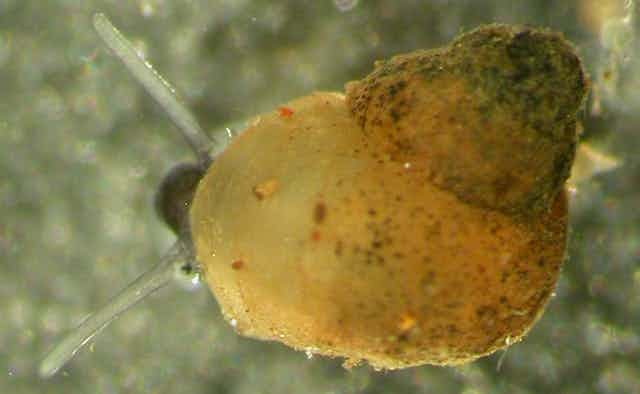While you’re worrying about pygmy-possums and hairy-nosed wombats spare a thought for some of Australia’s least known endangered species. Freshwater molluscs - snails, slugs and mussels - are in trouble right around the country. Two species from Tasmania might even be gone.
The freshwater snail Beddomeia tumida is one of dozens of species in Australia, but it is the only one that is exclusively found in a lake: all other species are stream-dwellers. With maximum size of around 4 mm, this species is easy to overlook.
Freshwater limpets are similarly minute, but Ancylastrum cumingianus is the world’s biggest freshwater limpet coming in at a whopping 12 mm: hence the grand epithet of “Great Lake Giant Limpet”. There are no recent photographs of this monster: you’ll have to be satisfied with Jules René Bourguignat’s original drawings when he described this species.
Both species are found in Great Lake, Australia’s second largest permanent freshwater lake by area. These two species are probably the most obscure of the many endemic and listed species in Great Lake, but their stories differ. One was once numerous and has all but disappeared. The other provides grounds for cautious optimism.

Status
Beddomeia tumida is one of 37 species of this genus listed as endangered under the Tasmanian Threatened Species Protection Act 1995 and appears restricted to Great Lake. The IUCN currently lists it as critically endangered but possibly extinct.
Happily, it appears to have been rediscovered during surveys of Great Lake by Hydro Tasmania in 2007, although better preserved specimens are needed by expert taxonomists to confirm this fully. Earlier surveys in the 1990s failed to find any specimens in shallow habitats or tributary streams of Great Lake, so these recent records suggest that this species prefers deeper waters.
By contrast, Ancylastrum cumingianus was more widespread, with records from Great Lake, Lake St Clair and some other lakes on the Tasmanian Central Plateau. It was once so common in the mid-1800s that specimens were sent to museums around the world. Sadly, however, the last museum records in Australia are from 1950, with the most recent specimens only recorded from the guts of introduced trout.
Threats
Ancylastrum cumingianus, like most in this group, is most likely associated with submerged aquatic plants. Virtually nothing has been recorded of its ecology. The introduction of trout has been implicated in its decline, but there is virtually no hard evidence.

Ecological knowledge of Beddomeia tumida is similarly scarce. Extrapolating from knowledge of its sister species, this snail is likely vulnerable to habitat degradation resulting from changes in catchment land use. Currently land use is light, but any intensification in the future or major changes in catchment vegetation as the climate gets drier could degrade habitat quality.
Because it appears to have persisted over the last 100 years of manipulations of Great Lake for hydroelectricity and irrigation supply, it is probably resilient to these modest changes in water level. Again, climate change may result in much more rapid, extreme and prolonged changes in water level which could threaten this species.
More immediate threats, however, are probably posed by inadvertent introduction of competitors such as the New Zealand mud snail, Potamopyrgus antipodarum.
Strategy
The lack of basic ecological information is the biggest obstacle to effective conservation of these species.
Concerted, rigorous surveys are urgently needed to determine whether Anycylastrum cumingianus is still with us. Without reassessing its status, further actions for this species are futile.
Now that Beddomeia tumida has potentially been rediscovered, the Threatened Species and Marine Section of Tasmania’s DPIPWE is finalising a Listing Statement for it using the recent data collected with Hydro Tasmania. Most of the planned actions are similar to those recommended for other species of Beddomeia: raise local awareness in the catchment of Great Lake to prevent degradation or loss of habitat.
There are already protocols to prevent the spread of exotic species and diseases. Continuing education campaigns to foster strong hygiene by anglers and boating enthusiasts will be vital to prevent invasion by exotic competitors such as Potamopyrgus antipodarum.
With these actions in place, attention should turn to researching the role of extreme and prolonged changes water levels on the habitats of these and other species endemic to Tasmania’s highland lakes. Under climate change, all of these lakes are at risk owing to reduced inflows and changed catchment vegetation as fires become more frequent and intense.
Conclusion
Cryptic, small threatened invertebrates are easily overlooked. Collectively, they have much to tell us about the evolutionary and biogeographic processes that we need to understand to adapt to and manage for climate change.
While things don’t look good for the largest freshwater limpet, our experience with Beddomeia tumida suggests that modest but targeted investigations can reveal some reasons to be cheerful in the otherwise glum prognosis for biodiversity in fresh waters worldwide.
It’s a story that could be repeated more often. Strategic, but modest investments can yield excellent returns for conserving such species.
The Conversation is running a series on Australian endangered species. See it here

